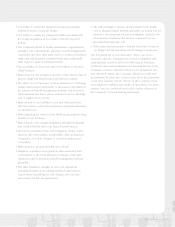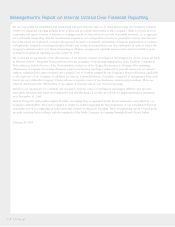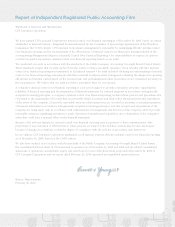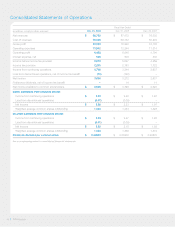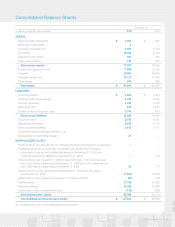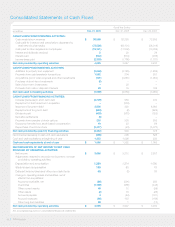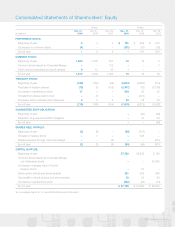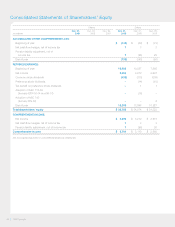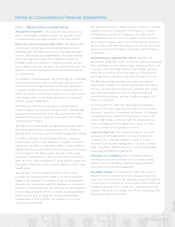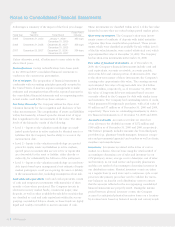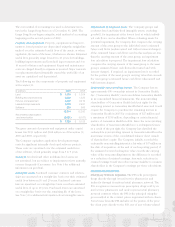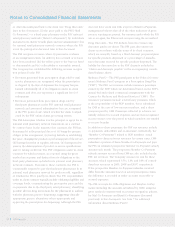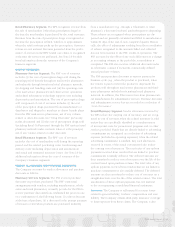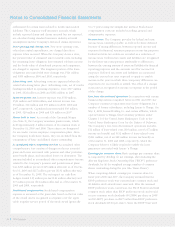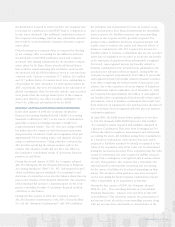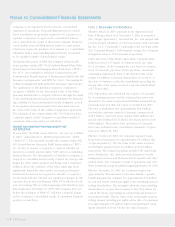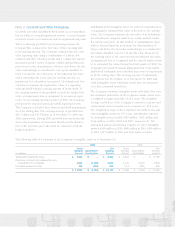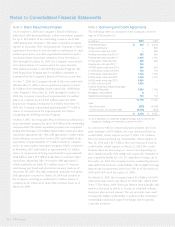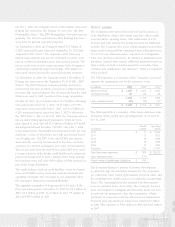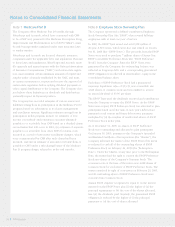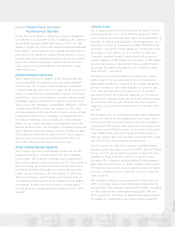CVS 2009 Annual Report Download - page 55
Download and view the complete annual report
Please find page 55 of the 2009 CVS annual report below. You can navigate through the pages in the report by either clicking on the pages listed below, or by using the keyword search tool below to find specific information within the annual report.
Impairment of long-lived assets. The Company groups and
evaluates fixed and finite-lived intangible assets, excluding
goodwill, for impairment at the lowest level at which individ-
ual cash flows can be identified. When evaluating assets for
potential impairment, the Company first compares the carrying
amount of the asset group to the individual store’s estimated
future cash flows (undiscounted and without interest charges).
If the estimated future cash flows used in this analysis are less
than the carrying amount of the asset group, an impairment
loss calculation is prepared. The impairment loss calculation
compares the carrying amount of the asset group to the asset
group’s estimated future cash flows (discounted and with
interest charges). If required, an impairment loss is recorded
for the portion of the asset group’s carrying value that exceeds
the asset group’s estimated future cash flows (discounted and
with interest charges).
Redeemable noncontrolling interest. The Company has an
approximately 60% ownership interest in Generation Health,
Inc. (“Generation Health”) and consolidates Generation Health
in its consolidated financial statements. The noncontrolling
shareholders of Generation Health hold put rights for the
remaining interest in Generation Health that if exercised would
require the Company to purchase the remaining interest in
Generation Health in 2015 for a minimum of $27 million and
a maximum of $159 million, depending on certain financial
metrics of Generation Health in 2014. Since the noncontrolling
shareholders of Generation Health have a redemption feature
as a result of the put right, the Company has classified the
redeemable noncontrolling interest in Generation Health in the
mezzanine section of the consolidated balance sheet outside
of shareholders’ equity. The Company initially recorded the
redeemable noncontrolling interest at a fair value of $37 million on
the date of acquisition. At the end of each reporting period, if
the estimated accreted redemption value exceeds the carrying
value of the noncontrolling interest, the difference is recorded
as a reduction of retained earnings. Any such reductions in
retained earnings would also reduce income available to common
shareholders in the Company’s earnings per share calculations.
REVENUE RECOGNITION:
Pharmacy Services Segment. The PSS sells prescription
drugs directly through its mail service pharmacies and
indirectly through its national retail pharmacy network. The
PSS recognizes revenues from prescription drugs sold by its
mail service pharmacies and under national retail pharmacy
network contracts where the PSS is the principal using the
gross method at the contract prices negotiated with its clients.
Net revenue from the PSS includes: (i) the portion of the price
the client pays directly to the PSS, net of any volume-related
The cost method of accounting was used to determine inven-
tory in the Longs Drug Stores as of December 31, 2008. The
Longs Drug Stores began using the retail method of accounting
beginning in the second quarter of 2009.
Property and equipment. Property, equipment and improve-
ments to leased premises are depreciated using the straight-line
method over the estimated useful lives of the assets, or when
applicable, the term of the lease, whichever is shorter. Estimated
useful lives generally range from 10 to 40 years for buildings,
building improvements and leasehold improvements and 3 to
10 years for fixtures and equipment. Repair and maintenance
costs are charged directly to expense as incurred. Major renewals
or replacements that substantially extend the useful life of an
asset are capitalized and depreciated.
The following are the components of property and equipment
at December 31:
in millions 2009 2008
Land $ 1,076 $ 1,304
Building and improvements 2,020 1,525
Fixtures and equipment 6,322 6,216
Leasehold improvements 2,673 2,581
Software 853 666
12,944 12,292
Accumulated depreciation
and amortization (5,021) (4,167)
$ 7,923 $ 8,125
The gross amount of property and equipment under capital
leases was $191 million and $182 million as of December 31,
2009 and 2008, respectively.
The Company capitalizes application development stage
costs for significant internally developed software projects.
These costs are amortized over the estimated useful lives
of the software, which generally range from 3 to 5 years.
Goodwill. Goodwill and other indefinite-lived assets are
not amortized, but are subject to impairment reviews annually,
or more frequently if necessary. See Note 3 for additional
information on goodwill.
Intangible assets. Purchased customer contracts and relation-
ships are amortized on a straight-line basis over their estimated
useful lives between 10 and 20 years. Purchased customer
lists are amortized on a straight-line basis over their estimated
useful lives of up to 10 years. Purchased leases are amortized
on a straight-line basis over the remaining life of the lease.
See Note 3 for additional information about intangible assets.
2009 Annual Report 51


